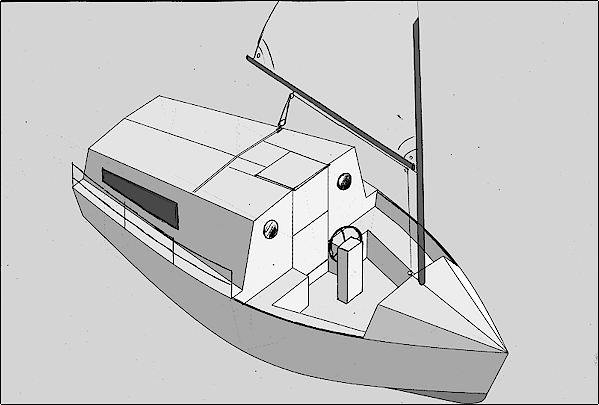|
Recto-verso
An unusual monohull yacht.
Marc Van Dessel marc.vandessel@siemens.atea.be
Specifications
|
Length overall |
6.00 m |
| Length waterline |
5.60 m |
| Length Trailering |
7.65 m |
| Beam |
2.50 m |
| Draught boards up |
0.35 m |
| Draught boards down |
1.45 m |
| Interior headroom |
1.55 - 1.85 m |
| Displacement empty |
750 kg (with water ballast filled) |
| Ballast |
300 (water) + 50kg (centerboard) |
| Trailering weight |
450 + 150 kg |
| Sail area |
15 sq. M |
| Mast height above WL |
8.5 m |
| Sleeps |
2 |
| Sails |
4 |
| Building complexity |
medium |
| Performance |
medium |
| Luxury |
very good |
Description
:This design is unusual. It turns the classic division
between cockpit and cabin around. Hence the name recto-verso.
Exterior
- The cockpit is in front of the cabin, just after the mast. The bow itself
is raised a bit to give protection to the cockpit. There are cockpit seats on the sides
but also on the back of the cockpit. From these forward-looking seats, one can easily
operate the steering wheel. This gives a very natural feeling for newcomers.
- The cockpit floor is raised to allow self-draining. The swinging
centerboard remains under the floor. This keeps the cockpit floor flat.
- The cabin table can be mounted on the steering pedestal.
- Just aft of the cockpit is the entry of the cabin. It is slightly offset
to starboard.
- A traveler runs on the cabin roof. It improves performance.
- The stern of the boat is accessible in the event of problems.
Interior
- By placing it at the back of the boat, the cabin is very wide. So no
V-berth but a real nearly square berth (2.0m x2.0m). During day, the berth is transformed
to a big dinette by raising the table. It seats 5.
- Also rare in a 6m boat is a real separate toilet room. It has comfortable
standing and sitting headroom.
- To the starboard side is a galley with full standing headroom (1.85m).
- The cabin floor is raised a bit at the dinette.
- Storage room is at the galley and under the seats.
Stability
- Ballast is used for stability. It is split in two parts.
- 300 kg water ballast under the cockpit floor.
- The centerboard has 50 kg of lead down low in the tip. The board can
swing up for trailering, beaching and safety.
- This high ballast ratio gives a smooth ride. This corresponds perfectly
to the design goal of Recto-verso where luxury is more important than performance.
Sail
- A cat rig is used. The main reason is to keep the mast as far to the bow
as possible in order to keep the cockpit free.
- The sail is kept relatively small. Performance is not the main goal.
- The mainsheet runs from the traveler on the cabin top to the mast-base
and the raised bow.
Motor
- The choice of motor is a difficult point for this design. Because the
motor is difficult to access, I recommend using an electric motor, which asks for less
attention. The heavy batteries can replace a part of the water ballast.
- Another option is to install a small inboard motor under the cockpit
floor.
Trailer
- A standard boat trailer can be used.
Building technique
- Stitch and glue with 8 mm ply is used. Every exposed surface is to be
covered with glass and epoxy.
Time to build
Cost
- 7000$ including motor and trailer
Pro's
- something completely different
- excellent view; first row experience
- appealing cockpit with seats looking forward
- self draining cockpit
- lot’s of interior space
- toilet in separate room
- king size berth (2.00 m x 2.00 m)
- seats 5 around the table
- water ballast gives low trailering weight combined with good stability
under sail
- easy to operate steering wheel
Con’s
- crew has less protection against wind and waves
- rudder is hard to reach when problems with the steering
- medium performance (high windage, cat rig)
|
Drawings




|